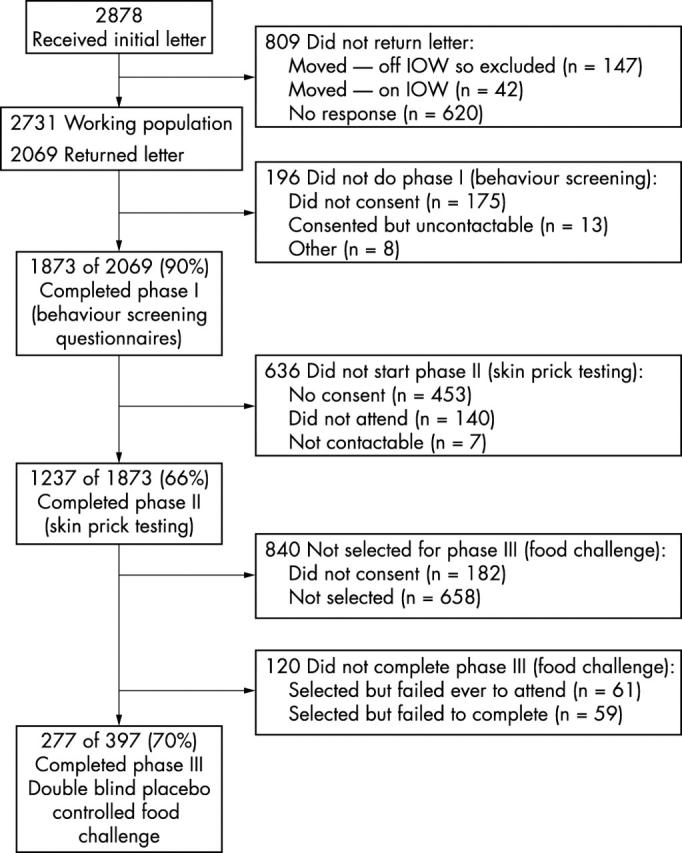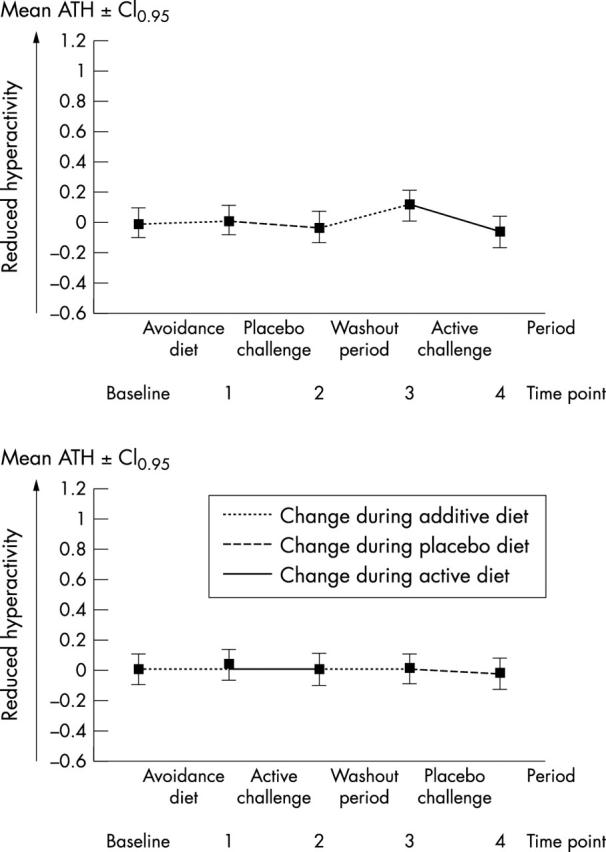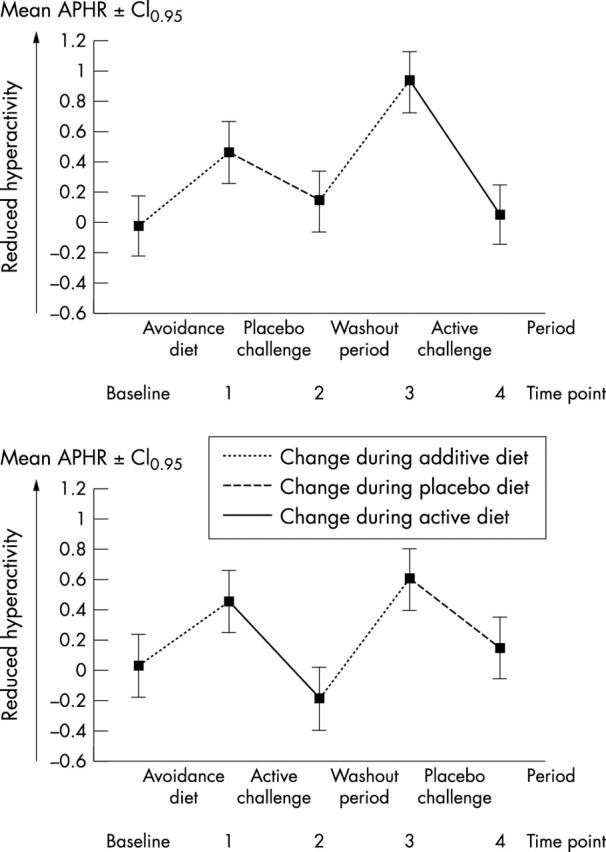Abstract
Aims: To determine whether artificial food colourings and a preservative in the diet of 3 year old children in the general population influence hyperactive behaviour.
Methods: A sample of 1873 children were screened in their fourth year for the presence of hyperactivity at baseline (HA), of whom 1246 had skin prick tests to identify atopy (AT). Children were selected to form the following groups: HA/AT, not-HA/AT, HA/not-AT, and not-HA/not-AT (n = 277). After baseline assessment, children were subjected to a diet eliminating artificial colourings and benzoate preservatives for one week; in the subsequent three week within subject double blind crossover study they received, in random order, periods of dietary challenge with a drink containing artificial colourings (20 mg daily) and sodium benzoate (45 mg daily) (active period), or a placebo mixture, supplementary to their diet. Behaviour was assessed by a tester blind to dietary status and by parents' ratings.
Results: There were significant reductions in hyperactive behaviour during the withdrawal phase. Furthermore, there were significantly greater increases in hyperactive behaviour during the active than the placebo period based on parental reports. These effects were not influenced by the presence or absence of hyperactivity, nor by the presence or absence of atopy. There were no significant differences detected based on objective testing in the clinic.
Conclusions: There is a general adverse effect of artificial food colouring and benzoate preservatives on the behaviour of 3 year old children which is detectable by parents but not by a simple clinic assessment. Subgroups are not made more vulnerable to this effect by their prior levels of hyperactivity or by atopy.
Full Text
The Full Text of this article is available as a PDF (235.0 KB).
Figure 1 .

Number of children completing each phase of the study.
Figure 2 .

Mean and 95% CI for standardised aggregated test hyperactivity (ATH) scores at five time points for the active-then-placebo and placebo-then-active groups; change during additive diet, change during placebo diet, change during active diet.
Figure 3 .

Mean and 95% CI standardised aggregated parental hyperactivity rating (APHR) scores at five time points for the active-then-placebo and placebo-then-active groups; change during additive diet, change during placebo diet, change during active diet.
Selected References
These references are in PubMed. This may not be the complete list of references from this article.
- Boris M., Mandel F. S. Foods and additives are common causes of the attention deficit hyperactive disorder in children. Ann Allergy. 1994 May;72(5):462–468. [PubMed] [Google Scholar]
- Carter C. M., Urbanowicz M., Hemsley R., Mantilla L., Strobel S., Graham P. J., Taylor E. Effects of a few food diet in attention deficit disorder. Arch Dis Child. 1993 Nov;69(5):564–568. doi: 10.1136/adc.69.5.564. [DOI] [PMC free article] [PubMed] [Google Scholar]
- Conners C. K., Goyette C. H., Southwick D. A., Lees J. M., Andrulonis P. A. Food additives and hyperkinesis: a controlled double-blind experiment. Pediatrics. 1976 Aug;58(2):154–166. [PubMed] [Google Scholar]
- Connor D. F., Fletcher K. E., Swanson J. M. A meta-analysis of clonidine for symptoms of attention-deficit hyperactivity disorder. J Am Acad Child Adolesc Psychiatry. 1999 Dec;38(12):1551–1559. doi: 10.1097/00004583-199912000-00017. [DOI] [PubMed] [Google Scholar]
- David T. J. Reactions to dietary tartrazine. Arch Dis Child. 1987 Feb;62(2):119–122. doi: 10.1136/adc.62.2.119. [DOI] [PMC free article] [PubMed] [Google Scholar]
- Feingold B. F. Hyperkinesis and learning disabilities linked to artificial food flavors and colors. Am J Nurs. 1975 May;75(5):797–803. [PubMed] [Google Scholar]
- Goyette G. H., Connors C. K., Petti T. A., Curtis L. E. Effects of artificial colors on hyperkinetic children: a double-blind challenge study [proceedings]. Psychopharmacol Bull. 1978 Apr;14(2):39–40. [PubMed] [Google Scholar]
- Gross M. D., Tofanelli R. A., Butzirus S. M., Snodgrass E. W. The effect of diets rich in and free from additives on the behavior of children with hyperkinetic and learning disorders. J Am Acad Child Adolesc Psychiatry. 1987 Jan;26(1):53–55. doi: 10.1097/00004583-198701000-00011. [DOI] [PubMed] [Google Scholar]
- Harley J. P., Matthews C. G., Eichman P. Synthetic food colors and hyperactivity in children: a double-blind challenge experiment. Pediatrics. 1978 Dec;62(6):975–983. [PubMed] [Google Scholar]
- Harley J. P., Ray R. S., Tomasi L., Eichman P. L., Matthews C. G., Chun R., Cleeland C. S., Traisman E. Hyperkinesis and food additives: testing the Feingold hypothesis. Pediatrics. 1978 Jun;61(6):818–828. [PubMed] [Google Scholar]
- Kaplan B. J., McNicol J., Conte R. A., Moghadam H. K. Dietary replacement in preschool-aged hyperactive boys. Pediatrics. 1989 Jan;83(1):7–17. [PubMed] [Google Scholar]
- Levy F., Dumbrell S., Hobbes G., Ryan M., Wilton N., Woodhill J. M. Hyperkinesis and diet: a double-blind crossover trial with a tartrazine challenge. Med J Aust. 1978 Jan 28;1(2):61–64. [PubMed] [Google Scholar]
- Mattes J. A., Gittelman R. Effects of artificial food colorings in children with hyperactive symptoms. A critical review and results of a controlled study. Arch Gen Psychiatry. 1981 Jun;38(6):714–718. doi: 10.1001/archpsyc.1981.01780310114012. [DOI] [PubMed] [Google Scholar]
- Murdoch R. D., Lessof M. H., Pollock I., Young E. Effects of food additives on leukocyte histamine release in normal and urticaria subjects. J R Coll Physicians Lond. 1987 Oct;21(4):251–256. [PMC free article] [PubMed] [Google Scholar]
- Murdoch R. D., Pollock I., Naeem S. Tartrazine induced histamine release in vivo in normal subjects. J R Coll Physicians Lond. 1987 Oct;21(4):257–261. [PMC free article] [PubMed] [Google Scholar]
- Pollock I., Warner J. O. Effect of artificial food colours on childhood behaviour. Arch Dis Child. 1990 Jan;65(1):74–77. doi: 10.1136/adc.65.1.74. [DOI] [PMC free article] [PubMed] [Google Scholar]
- Rowe K. S., Rowe K. J. Synthetic food coloring and behavior: a dose response effect in a double-blind, placebo-controlled, repeated-measures study. J Pediatr. 1994 Nov;125(5 Pt 1):691–698. doi: 10.1016/s0022-3476(94)70059-1. [DOI] [PubMed] [Google Scholar]
- Rowe K. S. Synthetic food colourings and 'hyperactivity': a double-blind crossover study. Aust Paediatr J. 1988 Apr;24(2):143–147. doi: 10.1111/j.1440-1754.1988.tb00307.x. [DOI] [PubMed] [Google Scholar]
- Schulte-Körne G., Deimel W., Gutenbrunner C., Hennighausen K., Blank R., Rieger C., Remschmidt H. Der Einfluss einer oligoantigenen Diät auf das Verhalten von hyperkinetischen Kindern. Z Kinder Jugendpsychiatr Psychother. 1996 Sep;24(3):176–183. [PubMed] [Google Scholar]
- Sonuga-Barke E. J., Thompson M., Stevenson J., Viney D. Patterns of behaviour problems among pre-school children. Psychol Med. 1997 Jul;27(4):909–918. doi: 10.1017/s0033291797005291. [DOI] [PubMed] [Google Scholar]
- Sonuga-Barke E., Stevenson J., Thompson M. J. Mental health of preschool children and their mothers in a mixed urban/rural population. II. Family and maternal factors and child behaviour. Br J Psychiatry. 1996 Jan;168(1):21–25. doi: 10.1192/bjp.168.1.21. [DOI] [PubMed] [Google Scholar]
- Supramaniam G., Warner J. O. Artificial food additive intolerance in patients with angio-oedema and urticaria. Lancet. 1986 Oct 18;2(8512):907–909. doi: 10.1016/s0140-6736(86)90423-x. [DOI] [PubMed] [Google Scholar]
- Swanson J. M., Kinsbourne M. Food dyes impair performance of hyperactive children on a laboratory learning test. Science. 1980 Mar 28;207(4438):1485–1487. doi: 10.1126/science.7361102. [DOI] [PubMed] [Google Scholar]
- Taras H. L., Sallis J. F. Blood pressure reactivity in young children: comparing three stressors. J Dev Behav Pediatr. 1992 Feb;13(1):41–45. [PubMed] [Google Scholar]
- Taylor E. Developmental neuropsychopathology of attention deficit and impulsiveness. Dev Psychopathol. 1999 Summer;11(3):607–628. doi: 10.1017/s0954579499002230. [DOI] [PubMed] [Google Scholar]
- Thompson M. J., Stevenson J., Sonuga-Barke E., Nott P., Bhatti Z., Price A., Hudswell M. Mental health of preschool children and their mothers in a mixed urban/rural population. I. Prevalence and ecological factors. Br J Psychiatry. 1996 Jan;168(1):16–20. doi: 10.1192/bjp.168.1.16. [DOI] [PubMed] [Google Scholar]
- Weiss B., Williams J. H., Margen S., Abrams B., Caan B., Citron L. J., Cox C., McKibben J., Ogar D., Schultz S. Behavioral responses to artificial food colors. Science. 1980 Mar 28;207(4438):1487–1489. doi: 10.1126/science.7361103. [DOI] [PubMed] [Google Scholar]
- Williams J. I., Cram D. M., Tausig F. T., Webster E. Relative effects of drugs and diet on hyperactive behaviors: an experimental study. Pediatrics. 1978 Jun;61(6):811–817. [PubMed] [Google Scholar]


